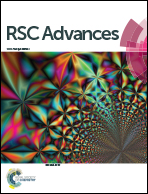High thermal stability and high tensile strength terpolyester nanofibers containing biobased monomer: fabrication and characterization†
Abstract
This research fabricated novel nanofibers with a terpolyester of isosorbide, ethylene glycol, 1,4-cyclohexane dimethanol, and terephthalic acid (PEICT) using electrospinning and characterized their properties. The nanofibers have higher glass transition temperature (Tg) than other polyester-type polymers, and a smaller diameter nanofiber has higher Tg than a larger diameter nanofiber. This is due to the orientation of polymer chains inside nanofibers, which was verified by DSC and polarized ATR-FTIR. The morphology and diameter of the nanofibers affected by concentration of PEICT solution were studied by SEM. It demonstrated smooth and well-formed nanofibers, and showed an increase of the diameter with increasing concentration. In addition, the tensile property, which was confirmed by UTM, was enhanced with increasing diameter because molecular orientation existed in finer nanofibers. They show a better tensile property than general biobased nanofibers such as silk, chitosan, and gelatin. Finally, fabrication of PEICT nanofibers was optimized and characterized. They can be utilized in various industrial applications such as tissue engineering, wound dressings, and health care devices.


 Please wait while we load your content...
Please wait while we load your content...